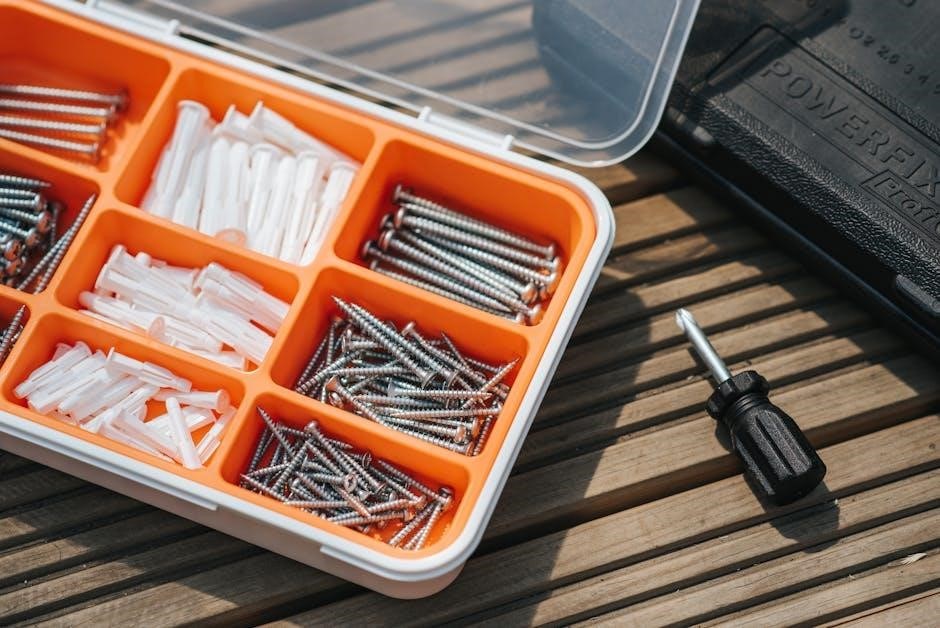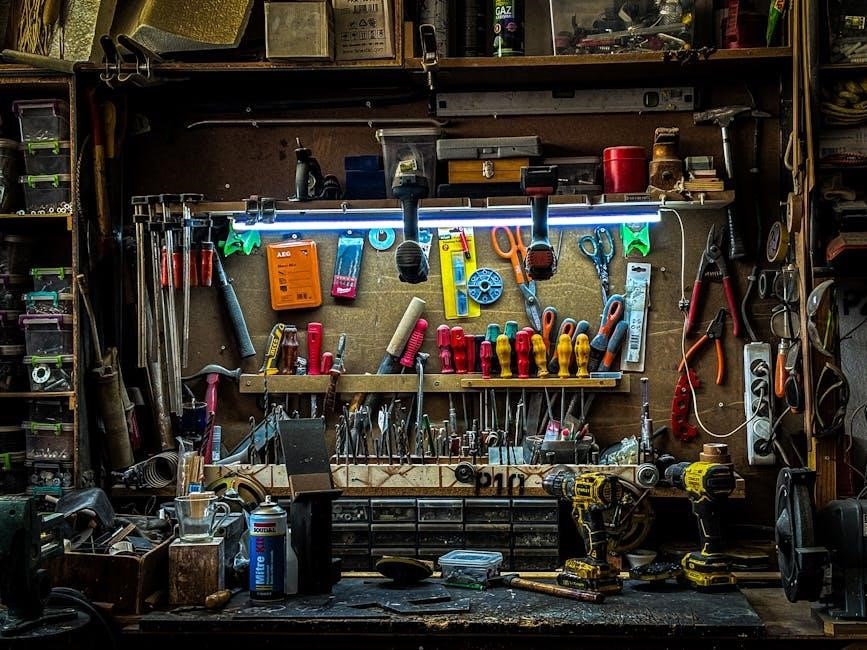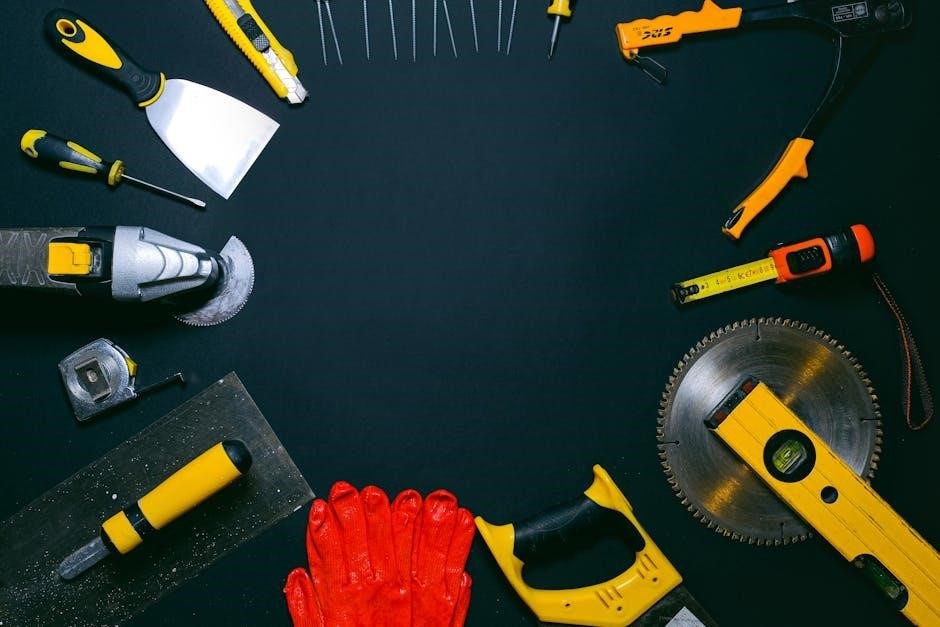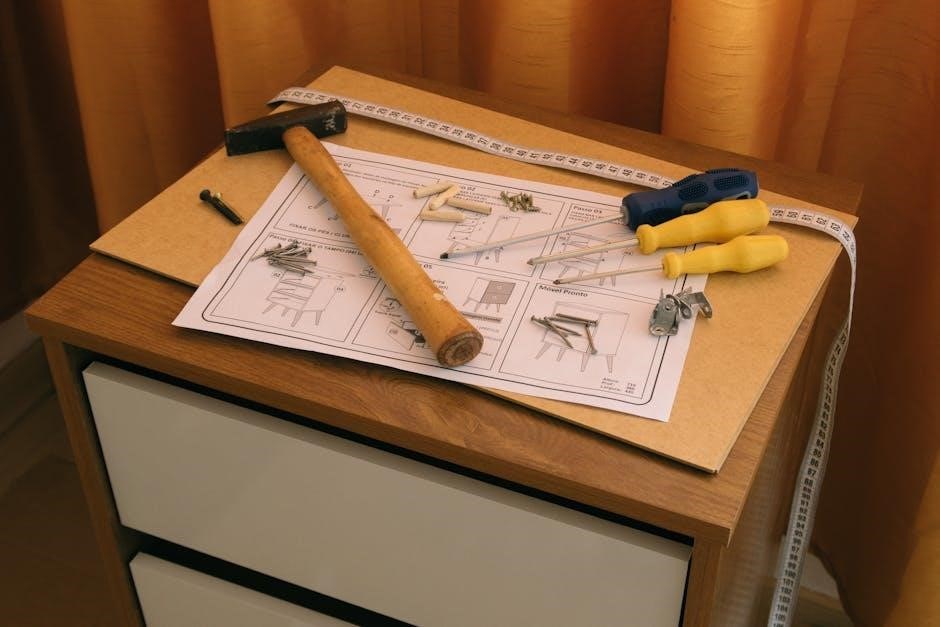Manual dumbwaiter kits offer a cost-effective, energy-efficient solution for moving items between floors, ideal for multi-level homes․ They enhance convenience and functionality, making them practical for transporting food, laundry, or other items․

History and Evolution of Manual Dumbwaiters
The concept of manual dumbwaiters dates back to ancient times, with the first recorded use around 200 BC by the Romans, who employed simple rope-and-pulley systems to move goods․ By the 19th century, dumbwaiters became common in large households, utilizing wooden guide rails and counterweight systems․ Initially, they were human-powered, relying on ropes or chains to lift and lower items․ Over time, designs evolved to include metal components and improved mechanisms for smoother operation․ The early 20th century saw the introduction of electric dumbwaiters, but manual systems remained popular for their simplicity and cost-effectiveness․ Today, manual dumbwaiters continue to be used in residential and commercial settings, offering a reliable, low-maintenance solution for transporting items between floors․ Their enduring appeal lies in their timeless functionality and adaptability to various architectural designs․

Benefits of Using Manual Dumbwaiter Kits
Manual dumbwaiter kits provide a cost-effective and energy-efficient solution for transporting items between floors, making them ideal for multi-level homes and commercial spaces․ They enhance convenience and functionality, allowing users to move food, laundry, or other items effortlessly․ These kits are versatile and easy to install, often requiring minimal structural modifications․ By eliminating the need for frequent stair usage, they save time and energy, especially in households with limited mobility․ Additionally, manual dumbwaiters are space-saving, fitting seamlessly into existing layouts without compromising design aesthetics․ Their simplicity and durability ensure long-term performance, making them a practical choice for both residential and commercial applications․ Overall, manual dumbwaiter kits offer a reliable and efficient way to streamline daily tasks while maintaining a sleek and functional environment․

Components of a Manual Dumbwaiter Kit
Manual dumbwaiter kits include a guide rail and trolley assembly, motor or gear assembly, dumbwaiter cab with gate system, and controller with safety features for smooth operation․
Guide Rail and Trolley Assembly
The guide rail and trolley assembly is a critical component of a manual dumbwaiter kit, ensuring smooth and stable movement of the cab between floors․ The guide rail is typically mounted along the hoistway, providing a fixed path for the trolley to glide on․ The trolley assembly includes wheels or rollers that fit snugly onto the guide rail, minimizing friction and preventing misalignment․ This system is designed to handle the weight of the dumbwaiter and its load securely, distributing the weight evenly for consistent performance․ Proper installation of the guide rail and trolley assembly is essential to maintain the dumbwaiter’s functionality and safety․ Over time, these components may require lubrication or adjustment to ensure optimal operation․ Their durability and precision engineering make them a cornerstone of reliable manual dumbwaiter systems․
Motor or Gear Assembly
In manual dumbwaiter kits, the motor or gear assembly is typically minimal, as these systems rely on manual operation rather than electric power․ However, some kits may include a gear system to assist with the lifting process․ These gears are designed to reduce the effort required to move the dumbwaiter, ensuring smooth and controlled movement․ The gear assembly often works in conjunction with pulleys and counterweights to balance the load, making it easier to pull the cab up or lower it down․ The components are usually made from durable materials, such as steel or high-quality alloys, to withstand regular use and heavy loads․ Proper lubrication of the gears is essential to maintain efficiency and prevent wear․ This assembly is a crucial part of the dumbwaiter’s functionality, providing reliability and ease of use in residential or light commercial settings․
Dumbwaiter Cab with Gate System
The dumbwaiter cab is the compartment that carries items between floors and is typically constructed from durable materials such as cabinet-grade birch, stainless steel, or powder-coated steel․ Its size varies, but common dimensions for residential use include 20 inches in width, 16 inches in depth, and 30 inches in height․ The cab is designed to be spacious enough to accommodate items like food trays, laundry, or small packages․ A key feature of the cab is the gate system, which is usually a sliding or hinged door that locks securely to ensure safe operation․ The gate system is designed to prevent accidental opening during transit and often includes a manual locking mechanism․ The cab’s interior is typically smooth and easy to clean, making it practical for daily use․ The design ensures efficient movement of goods while maintaining safety and durability․
Controller and Safety Features
The controller in a manual dumbwaiter kit is a simple yet essential component that ensures smooth operation․ It typically includes a variable frequency drive (VFD) or a basic mechanism to control the movement of the cab․ Safety features are paramount, with door interlocks being a standard inclusion to prevent the gates from opening during transit․ Emergency brakes or manual locks are also integrated to halt the system if needed․ Additionally, the controller often includes sensors to detect overloads or misalignment, enhancing overall safety․ These features work in tandem with the rope or chain system to provide a secure and reliable operation․ Higher-end models may offer advanced controls, such as soft-start mechanisms, to reduce wear and tear․ Together, these components ensure the dumbwaiter operates efficiently while safeguarding users and their belongings․

Installation Process of Manual Dumbwaiter Kits
Manual dumbwaiter kits are designed for easy installation, typically completed in one day․ They include pre-assembled components and necessary hardware for seamless integration into existing structures․
Residential Installation Considerations
Residential installation of manual dumbwaiter kits requires careful planning to ensure seamless integration into home environments․ These systems are designed for multi-level homes, offering a practical solution for transporting items like food, laundry, or groceries between floors․ With weight capacities typically ranging from 100 to 300 lbs, they are ideal for light to moderate use․ Installation usually takes one day, as kits include pre-assembled components such as guide rails, pulleys, and cabinets․ Proper space planning is essential, with considerations for shaft dimensions and door openings․ The pulley system must be securely anchored to load-bearing structures to ensure safety and durability․ Residential installations often involve simpler configurations compared to commercial setups, making them more accessible for homeowners․ Additionally, manual systems are energy-efficient and cost-effective, making them a popular choice for enhancing convenience in residential spaces․
Commercial Installation Considerations
Commercial installations of manual dumbwaiter kits require careful planning to meet the demands of high-traffic environments․ These systems are ideal for restaurants, bars, and hospitality venues, where efficient movement of food, drinks, and supplies is essential․ Weight capacities for commercial use typically range from 200 to 300 lbs, ensuring durability for frequent use․ Installation must comply with local building codes and fire safety regulations, often requiring fire-rated doors and secure anchoring systems․ Space optimization is critical, as commercial dumbwaiters must fit into existing layouts without disrupting workflow․ Additionally, noise reduction measures may be necessary in busy environments․ While manual systems are cost-effective, they may be less suitable for very high-demand settings, where electric dumbwaiters are often preferred․ Proper maintenance and regular inspections are vital to ensure long-term reliability and safety in commercial applications․
Cost Considerations and Budgeting
Manual dumbwaiter kits are a budget-friendly option for moving items between floors, with costs varying based on size, weight capacity, and features․ Basic residential models typically range from $2,000 to $4,000, including installation, while larger or commercial units can cost between $10,000 and $40,000․ Factors such as material quality, lifting distance, and customization options also influence pricing․ For residential use, a standard dumbwaiter with a 100-200 lb capacity and two stops may cost around $2,000, plus $750 for installation․ Commercial installations, requiring heavier-duty systems, start at $10,000 for a new shaft and motorized lift․ Dumbwaiter kits, being pre-assembled, are generally more affordable than custom-built units while offering similar quality․ Budgeting should also account for potential upgrades, such as fire-rated doors or advanced safety features, ensuring the system meets specific requirements․ Overall, manual dumbwaiter kits provide a cost-effective solution for efficient vertical transportation in both homes and businesses․
Maintenance and Upkeep Requirements
Regular maintenance is essential to ensure the smooth operation and longevity of manual dumbwaiter kits․ Routine tasks include lubricating pulleys and guide rails to reduce friction and wear․ The ropes and counterweights should be inspected periodically for signs of wear or damage, ensuring they remain properly balanced․ Cleaning the track and cab is also crucial to prevent debris buildup, which could hinder performance․ Additionally, the brake system should be checked to ensure it locks securely when not in use; Users are advised to refer to the installation manual for specific maintenance schedules and guidelines․ Proper upkeep not only enhances safety but also prevents unexpected breakdowns, making manual dumbwaiters a reliable choice for long-term use in both residential and commercial settings․ Consistent care ensures optimal functionality and extends the lifespan of the system․

Troubleshooting Common Issues
Common issues with manual dumbwaiter kits often stem from wear and tear of moving parts․ Frayed ropes or rusty pulleys can cause malfunctions, while misaligned guide rails may lead to operational difficulties․ Improper counterweight adjustments can result in uneven movement or the system getting stuck․ The brake system, if not functioning correctly, may cause unexpected movement or failure to stop․ Obstructions in the shaft, such as debris or oversized items, can block the dumbwaiter’s path․ Door mechanisms may also fail to open or close properly, hindering operation․ Additionally, rope slippage due to inadequate securing or wear can affect ascent and descent․ User error, such as overloading or incorrect use, can exacerbate these problems․ Regular inspections and maintenance, including lubricating pulleys and checking counterweights, are crucial for smooth functionality and safety․ Addressing these issues promptly ensures reliable performance and longevity of the system․

Design and Space Considerations
Design and space considerations are critical when installing a manual dumbwaiter kit․ The system must fit seamlessly into the building’s layout, ensuring functionality and safety․ Typical dumbwaiter trays range from 20 inches wide and 16 inches deep, with heights around 30 inches, requiring adequate clearance for smooth operation․ The shaft must align with the tray size and floor-to-floor height, while pulley placement and rope length should allow easy operation․ Custom designs can adapt to unique spaces, but standard kits offer pre-set dimensions․ Proper installation ensures the system is user-friendly and efficient, enhancing convenience without compromising space․ Attention to these details ensures the dumbwaiter integrates well, providing reliable service for years․ Regular inspections and adjustments are essential to maintain optimal performance and safety․

Outdoor Dumbwaiter Kits
Outdoor dumbwaiter kits are ideal for transporting items like groceries or luggage between ground and upper levels, saving space and effort․ They enhance convenience and home value․
Design Considerations for Outdoor Use
When designing an outdoor dumbwaiter, durability and weather resistance are key․ Kits should include materials like stainless steel or powder-coated finishes to withstand rain, wind, and UV exposure․ The shaft must be securely anchored to prevent swaying, and the system should have protective features like weatherproofing to ensure reliable operation․ Consider the weight capacity and size based on intended use, such as moving groceries or furniture․ Proper installation in a sheltered location or with additional cover can enhance longevity․ Safety features, such as load capacity warnings and smooth operation mechanisms, are essential for outdoor use․ Regular maintenance is also crucial to ensure the system remains functional in harsh conditions․ An outdoor dumbwaiter can significantly enhance convenience and home value, making it a practical investment for multi-level properties․
Customization Options for Manual Dumbwaiters
Manual dumbwaiter kits can be tailored to meet specific needs, offering flexibility in design and functionality․ Users can choose from various materials, such as cabinet-grade birch, stainless steel, or powder-coated finishes, ensuring durability and aesthetic compatibility․ Weight capacities range from 100 to 300 lbs, allowing customization based on intended use․ Kits often include adjustable components, such as guide rails and gate systems, to fit different spatial requirements․ Additional features like variable frequency drives or customizable door options enhance functionality․ Some manufacturers provide pre-hung fire-rated doors for commercial settings, while residential users can opt for designs that blend seamlessly with home décor․ Customization ensures that the dumbwaiter integrates efficiently into existing structures, whether for moving food, laundry, or other items, making it a versatile solution for both homes and businesses․

Future Trends in Dumbwaiter Technology
Manual dumbwaiter kits are evolving with advancements in technology, offering smarter and more efficient solutions․ Future trends include integration with smart home systems, allowing users to control dumbwaiters via smartphones or voice assistants․ Energy-efficient designs, such as regenerative braking systems, are being developed to reduce power consumption․ Compact, space-saving models with modular components will cater to urban living spaces․ Additionally, there is a growing focus on eco-friendly materials and quieter operation for residential use․ Enhanced safety features, like automatic braking and collision detection, are expected to become standard․ Customizable options, such as app-controlled access and real-time monitoring, will further personalize the user experience․ These innovations aim to make dumbwaiters more versatile, sustainable, and seamlessly integrated into modern lifestyles, ensuring they remain a practical and desirable solution for multi-level spaces․
Manual dumbwaiter kits have proven to be a practical and efficient solution for moving items between floors, offering a blend of simplicity, cost-effectiveness, and versatility․ Their enduring popularity stems from their ability to enhance convenience in both residential and commercial settings․ Whether for transporting food, laundry, or other essentials, these kits provide a reliable and energy-efficient alternative to traditional elevators․ With advancements in design and technology, manual dumbwaiters continue to evolve, incorporating safer, quieter, and more sustainable features․ Their adaptability to various spaces and needs ensures they remain a valuable addition to multi-level homes and businesses․ As technology progresses, future models are expected to offer even greater customization and smart integration, solidifying their place as a timeless and practical solution for modern lifestyles․

FAQ and Common Inquiries
Frequently Asked Questions about manual dumbwaiter kits often revolve around their functionality, installation, and cost․ Homeowners and businesses commonly inquire about weight capacities, which typically range from 100 to 300 lbs, depending on the model․ Another common question is whether installation requires professional help, with many kits designed for DIY setup․ Cost inquiries often focus on the price range, which starts around $2,000 for basic models, including installation․ Users also ask about customization options, such as size and material choices, to fit specific spaces․ Additionally, questions about maintenance and upkeep are frequent, with most kits requiring minimal care․ Finally, many potential buyers inquire about warranty options and customer support, which vary by manufacturer․ These kits remain a popular choice for their practicality and ease of use․
